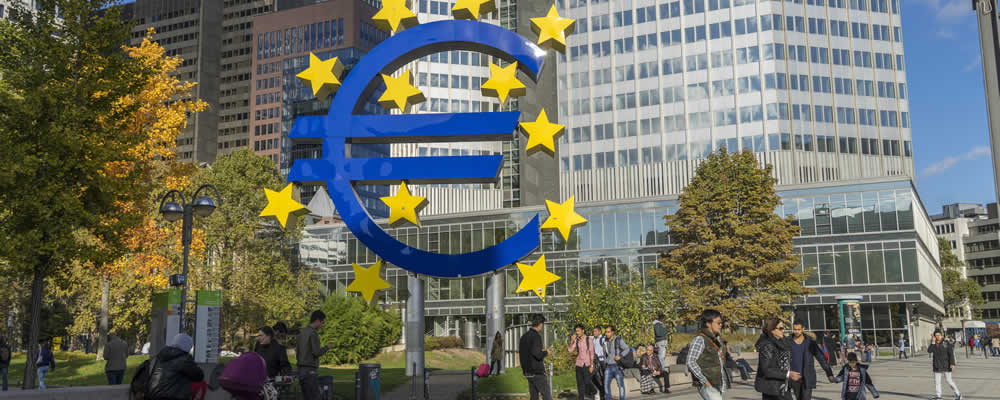- EUR GBP Exchange Rate Trends Near 0.87 – Flat near week’s opening levels
- UK PMIs Disappoint So Far – Manufacturing and construction below expectations
- EUR Forecast: ECB Speeches This Week – Composite PMIs on Wednesday
- GBP Forecast: UK Services PMI in Focus – Could alter BoE tightening bets
Both the Euro and the Pound saw limp trade throughout Tuesday’s European session, leading to flat trade in the EUR GBP exchange rate.
Tuesday afternoon saw European Central Bank (ECB) chief economist Peter Praet hold a speech, in which he indicated he didn’t feel the Eurozone was ready to have the bank’s stimulus scheme withdrawn.
While he believed the asset purchase scheme had helped inflation to recover, he argued;
But measured inflation remains exceedingly volatile and metrics of underlying price pressures continue to be subdued. The entire distribution of inflation expectations still needs to shift a fair distance to the right.
As a result, Euro traders hesitate to buy further into the shared currency. EUR strength could be limited until more ECB officials take on more hawkish stances.
[Published 10:40 BST 04/07/2017]
The EUR GBP exchange rate has seen little movement this week as investors are awaiting more influential news and data before trading. Any comments from European Central Bank (ECB) officials as well as Britain’s services PMI could impact the Euro Pound pair.
EUR GBP’s largely flat trade has lasted for over a week now. Last week saw the pair only slip slightly from 0.8800 to 0.8770, where the pair continues to trade near.
Euro (EUR) Flat Despite Optimistic Eurozone Stats
The Euro has been unable to capitalise on recent better-than-expected Eurozone ecostats, due to market uncertainty about how hawkish the European Central Bank’s (ECB) monetary policy outlook could become.
Last week, ECB President Mario Draghi indicated the bank could begin discussing tightening the bank’s aggressive quantitative easing (QE) measures before the end of the year, but some investors interpreted this to mean that QE was already planned to be withdrawn.
As ECB sources clarified that Draghi only intended to make markets aware of the possibility that QE withdrawal will be discussed, investors are now looking for forward guidance from other ECB officials before making big moves on the Euro.
This week’s optimistic Eurozone ecostats have supported the Euro but not boosted it higher.
Monday saw the publication of Markit’s final June manufacturing results, which improved from 57 to 57.4 in the Eurozone and beat 57.3 projections. This was due to strong manufacturing data from Germany, Austria and The Netherlands.
The Eurozone’s May unemployment rate didn’t improve to the forecast 9.2%, but still remained at a solid eight-year-low of 9.3%.
Pound (GBP) Limp as PMIs Fail to Meet Expectations
While investors are still awaiting Britain’s services PMI, due Wednesday, Markit’s other PMI prints from June have fallen short of expectations and this has made investors hesitant to buy the Pound.
So far, Markit’s June manufacturing and construction PMIs have been published.
The UK manufacturing print was forecast to come in at 56.5 but instead dropped from 56.3 to 54.3. The construction PMI was forecast to slip from 56 to 55, but came in at a lower 54.8.
Investors are becoming increasingly concerned that Britain’s economic activity is slowing due to the uncertainties of the Brexit process as well as the value of the Pound, which has caused inflation to rise and wage growth to slow.
According to Tim Moore from Markit;
‘Survey respondents commented on renewed caution among clients, in response to heightened political and economic uncertainty. Fragile business sentiment led to delayed decision-making on large projects and greater concern about the outlook for workloads during the next 12 months.’
The latest Bank of England (BoE) news also kept the Pound under pressure. Investor hopes for the BoE to tighten UK monetary policy have been limited by underwhelming UK ecostats, as well as news that dovish policymaker Gertjan Vlieghe still opposed tighter rates.
EUR GBP Exchange Rate Forecast: Services Stats Ahead
Wednesday will be a key session for the EUR GBP exchange rate, as influential ecostats from both the Eurozone and Britain will be published throughout the day.
Markit will be publishing its final June services and composite PMIs for both the Eurozone and Britain.
As services make up a notable fraction of Britain’s economic activity, a worse-than-expected UK services report could lead to Pound weakness in the coming days.
Poor services stats would increase concerns that Britain’s economy is being negatively affected by the household pay squeeze, which may make it harder for Bank of England (BoE) policymakers to agree to tighter monetary policy any time soon.
The Euro, on the other hand, could react to any comments from European Central Bank (ECB) officials, as well as May retail sales stats for the bloc.
Kit Juckes from Societe Generale speculates that the Euro Pound exchange rate has higher to go in the coming months;
‘Gertjan Vlieghe makes the dovish case that hiking too soon is worse than hiking too late, Ian McCafferty is quoted on news wires restating his view that to tighten would be appropriate.
Meanwhile, the slow deterioration of the economy continues against a backdrop of equally slow-moving Brexit negotiations. The road to EUR/GBP 0.90 and beyond will be rocky and slow, but we’re on it all the same.’
Euro Pound Interbank Rate
At the time of writing this article, the EUR GBP exchange rate trended in the region of 0.8780. The Pound Euro exchange rate traded at around 1.1388.



